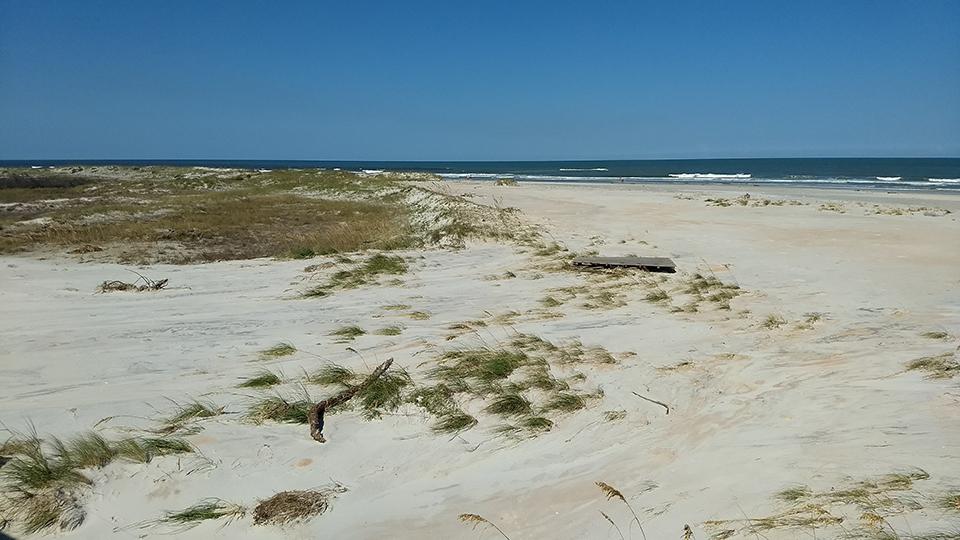
Hurricane debris at Fort Matanzas/Chris Farrell.
Editor's note: This is the first article in a partnership series by Audubon Florida, connecting National Parks Traveler readers with avian stories from the Sunshine state's national park sites.
The coquina walls of Fort Matanzas cast long shadows along the water of the Matanzas Inlet in northeast Florida, the sun setting in bursts of red and gold. Along the sandy shores of the waterway, multi-species flocks of sea and shorebirds are settling down for the night, chicks and parents lying directly on the warm sand. It’s nesting season on Florida’s coast.
Chris Farrell, Audubon Florida’s northeast policy associate, organizes volunteer and staff bird stewards to safeguard the nesting colony, which is found within the Matanzas Inlet Critical Wildlife Area. Across the state, Audubon Florida enlists hundreds of stewards to help protect the imperiled birds that nest on some of the busiest and most developed beaches in the country.
“Fort Matanzas National Monument includes a mosaic of coastal habitats, but the relatively open sand on the southern point of the park is the most valuable to our vulnerable shorebirds,” Farrell explains. “Overwash from recent hurricanes increased the amount of open sand in the park and restored desirable conditions for Least Terns to nest with a sizable colony.
Least Terns are diminutive seabirds, migrating from South America in the spring to breed in the United States. These tiny white birds with black caps and yellow bills patrol the shoreline for tiny fish to feed their mates and young.
Historically, the national monument hosted the largest Least Tern colony in the region, but shifting sands eventually reduced the available habitat to such an extent that the nesting terns disappeared altogether. Today, the colony has returned and now reaches around 60 adult birds, with chicks at various ages as some terns nest a second time after a first failed attempt. As of late June, there were 29 nests with many chicks on the way.

Least Terns/Emily Carter Mitchell.
Where the sand in the monument forms low dunes, Wilson’s Plovers also nest in shallow scrapes directly on the ground. Pale brown above and white below, with a large black bill, Wilson’s Plovers only reach about eight inches in length and are known for their energetic feeding activity.
“We have very few Least Tern colonies on the Atlantic Shore in Florida, so Fort Matanzas is a critically important nesting site,” Farrell continues. “Audubon Florida, the Florida Fish and Wildlife Conservation Commission (FWC), and the National Park Service are working together to address the threats these shorebirds face while nesting.”
Their greatest threats? Humans and predation. Chicks and nests can be difficult to see, and when people unwittingly come too close to the colonies - or worse, light illegal, personal fireworks nearby - adult birds will flush leaving eggs and chicks exposed to harm. Natural predators, including other birds, mammals, and ghost crabs, can go after the young birds.
Working with a variety of government partners and dedicated volunteers, Audubon and FWC hope to increase the populations of these shore and seabirds by 10 percent over the next ten years. Least Terns are already listed as threatened by the State of Florida, while the Wilson’s Plover is protected from direct harm under the Federal Migratory Bird Treaty Act.
Visitors to the park this summer are reminded to enjoy the colony from a safe distance using binoculars or spotting scope, as the fuzzy baby birds make their first forays into the world. Come August, the colonies will begin to quiet, and soon after the birds will disappear from Fort Matanzas altogether, at least until the 2020 nesting season!
If you are interested in becoming a beach steward or participating in coastal conservation volunteer activities, please send an email with your name, telephone number, and general location to [email protected].

 Support Essential Coverage of Essential Places
Support Essential Coverage of Essential Places







Comments
Thank you for very interesting article. I have been a Nesting Shorebird monitor Volunteer for 15 seasons and it is wonderful to read this informative article. Fort Matanzas National Monument is a Top Birding Spot. Thank you, Chris Farrell.
If this is such a critical nesting site why is there a commercial contractor renting out jet skies and campsites and throwing a concert there this weekend? It's sickening and the trash is out of control in the nesting sites?
This area is now being commercialized. No one cares. It worries one for the wildlife